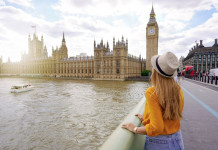One of the most iconic sights in London, Tower Bridge is a beautiful example of the city’s architecture and engineering combining to create a stunning work of art and transport mobility. Easy to reach from Central London and the Grand Royale London hotel, this beautiful bridge is more than just a byway over the Thames. With a lot of history and its own museum, there’s plenty to see and do on a visit to this bridge.
Whether you walk, drive, tour or simply see it from a distance, this blog will explore everything you need to know about Tower Bridge, its history and its features. For sightseeing accommodation Hyde Park guests, this is one of the must see attractions in London.
What Is Tower Bridge?
A suspension bridge built between two 65 metre towers, Tower Bridge connects East London to the centre of the city. With its light blue rimmed edges and walkways and majestic spires, the bridge has become one of the most well known landmarks in London, even being used as a logo and a shorthand for London by a range of companies.
Design Of Tower Bridge
Designed in the Gothic style to match many of the city’s other landmarks, Tower Bridge was designed as a bascule bridge – or drawbridge – to allow sailing ships to travel through to St Katharine’s Dock whilst also allowing for transport from one side of the river to the other. The counterbalanced bascules each weigh 1000 tons so that the bridge’s walkway can rise in no more than five minutes.
The bridge not only has a road running through it, but a path on each side for pedestrians. The two towers that rise to 65 metres near the centre of Tower Bridge also have a walkway between them near the top of their parallel spires and can be accessed by a lift service but once only had stairs. This ingenious design also has aesthetic flair, probably giving it first place in terms of London’s best known bridges.
History Of Tower Bridge
Tower Bridge was built due to an increased need from businesses and companies for a trade route from the City of London into the East End. Over 7 years, designs were pitched to a committee of experts for a new bridge close to London Bridge. The eventual decision was to create a bascule bridge and the architect was Sir Horace Jones with John Wolfe Barry on engineering duties.
After 8 years, the bridge was eventually completed, with the walkways and towers built using cornish granite and portland stone on top of steel frameworks. The original brickwork on the towers were replaced by ornate Victorian Gothic stylings and when it was opened in June 1894, the bridge had cost the equivalent of 138 million to complete.
Where Is Tower Bridge?
Tower Bridge is located between Tower Hill, the home of the Tower of London and on its southern banks between London Bridge and the Bermondsey areas. This plants it right in the commuter heart of London and provides a beautiful view over the meandering Thames on each side.
How To Get To Tower Bridge
Easy to reach via the London Cycling Superhighway and within 45 minutes tube journey from Hyde Park meeting rooms, Tower Bridge can be accessed by road, river and underground. The closest underground and train stations to Tower Bridge are Tower Hill on the Circle and District Lines, London Bridge on the Northern and Jubilee Lines and Bermondsey on the Jubilee Line. The DLR line runs through Tower Gateway whilst the closest national rail stations are Fenchurch Street and again, London Bridge.
Tower Bridge Exhibition
One of the main tourist draws for visitors of Tower Bridge are its exhibitions, situated within the towers and high level walkways. Utilising archive film and photography, the exhibition explores the creation of the bridge and provides access to what were once the power sources behind the hydraulic bascules – steam engines. Ticket prices for adults are £11.40 whilst children over the age of 5 and under 15 can visit for £5.70. Tours of the bridge start at £20 per head for adults.
Glass Floor
One of the most popular attractions on Tower Bridge is its glass floor tower walkways, 42 metres above the Thames and 33.5 metres above the road below. With a mirrored ceiling making photos even easier, this unforgettable experience is a testament to the awe and innovation of the bridge.
Engine Rooms
One of the most magnificent parts of the tour are the engine rooms, now defunct but still a marvel to behold. The engine rooms were built to control the hydraulics of the drawbridge, but have now been replaced by oil. The engine rooms, then, are now paeans to Victorian ingenuity, and show renovated Victorian coal boilers, drivetrains and accumulators, all of which helped bring the bridge to life in the late 19th century.
Galleries
The multimedia, interactive galleries of Tower Bridge provide in depth information into the bridge’s conception and creation, all accessible for adults and children alike. Whilst the exhibition itself will take you between half an hour and an hour to complete, the galleries will absorb and transport you.
What To See Near Tower Bridge
Tower Bridge is nestled close to the heart of Central London and has many other historic landmarks and districts just a stone’s throw away. For visitors of bars near Hyde Park, Tower Bridge’s proximity to London Bridge’s entertainment district makes it the perfect stop off on your way to a London Bridge night out. Here you’ll find an abundance of bars, restaurants and busy market stalls in Borough market, whilst Bermondsey Street attracts coffee and art lovers alike to exhibition spaces such as the White Cube and many artisan cafes.
Another attraction you can join your visit to Tower Bridge with is the nearby Tower of London. Built in the late 11th century, the Tower of London has been a constant presence in the city and has seen its White Tower and crypts used for everything from jail cells to animal menageries. A day trip to both the Tower of London and Tower Bridge will see visitors walk through a complete mediaeval and Victorian history of the city.









